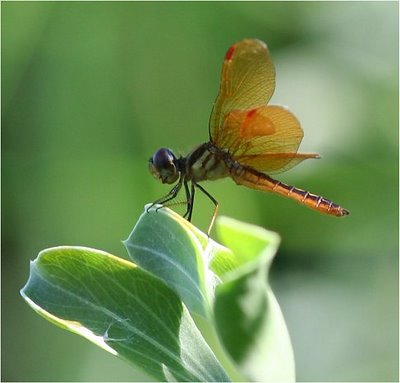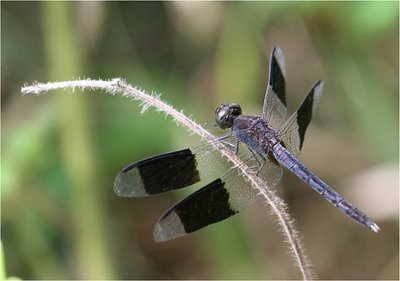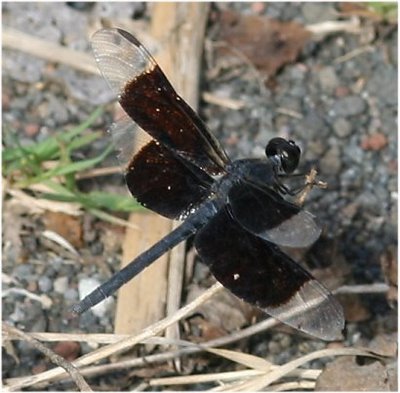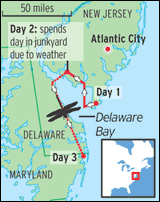In the 1940s, a decade before achieving international renown with “Lolita,” Vladimir Nabokov solidified his reputation as a lepidopterist by reclassifying the wide-ranging North American butterfly genus Lycaeides, the “blues.”Molecular biologists have proved him right, finding that a population of hybrid L. melissa x L. idas, high in the Sierra Nevada above the habitats of both parent species. Read more here.
Nabokov divided the blues into two large species — Lycaeides melissa, the Melissa blue, and Lycaeides idas, the northern blue, with overlapping ranges in the mountains of the West. He also theorized that the blues he found high in the Tetons and Colorado Rockies were hybrids, but he lacked the tools to prove it.
19 December 2006
Nabokov's blues
A neat article in the New York Times:
09 October 2006
06 October 2006
Dos Dragonlets
01 October 2006
Dragonfly schwag

This was quite a splurge, but I've been eyeing it for some time, and finally gave in. How cool will it be to give out my business card from this groovy holder, from Kyle Design?
09 September 2006
Elusive Clubtail no longer eludes us
Buoyed by our success at Humbug a couple weeks ago, we returned last weekend two days in a row. It was breezy and cool, and just about everything eluded us. Russet-tippped Clubtails were still present, but we saw them in lower numbers. Nearly the whole brownfield is covered with goldenrods and eupatorium, and the bee and wasp numbers were truly impressive. When I told Mark about this, he and his wife accepted our invitation to try again for odes and hymenopterans; although Mark is the #1 ode guy in the state, his original expertise is wasps. I'd say there were more bees and spiders and the wasp diversity was diminished from last weekend. He'll have to report on the stuff he and his wife found, I'll stick to the ode storyline.
We were once again on the hunt for hanging clubtails. We saw only one Russet-tipped Clubtail, but were hopeful to voucher Arrow Clubtail (Stylurus spinceps). And both of us had seen some smaller, dark Stylurus in these recent trips, and the candidate foremost in our minds was, S. notatus, Elusive Clubtail. Typically a treetop dweller, they are...elusive. The only county records were two larval specimens taken in 1984 from the Detroit River at Grosse Ile. The distance between the Humbug brownfield and Grosse Ile can be measured in yards.
After an hour or so of wandering, I got a radio call from Stylurus that he had nabbed a male Stylurus. When I looked at it, I was pretty sure it was not S. spinceps, it did not seem large enough. And the teal-blue eyes sure looked familiar to me. We had netted a female notatus in Wisconsin some years ago. I trotted it over to Mark, who confirmed the genus and thought it was probably spiniceps. We had nets and camera gear up the ying-yang, but no gomphid genitalia cheat sheets, so we continued our exploration until we were once again caught by rain.
Back home, a quick look at the hamules and length of abdominal segment 9 confirmed my initial hunch: this was Stylurus notatus. In the photo below, check out the long hamule on the reference specimen of S. spiniceps on the top, compared to the small, pointy hamule on the S. notatus below it.
 Spiniceps also has a very long segment 9, around 1.25 times longer than s8, while these two segments are about the same length in notatus. Below, notatus is on top.
Spiniceps also has a very long segment 9, around 1.25 times longer than s8, while these two segments are about the same length in notatus. Below, notatus is on top.
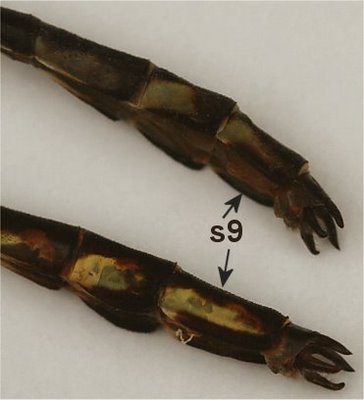 This is the first adult specimen for Wayne County, and only the ninth adult specimen for the state. Elusive Clubtail is a species of special concern for Michigan, so we consider it a great success that we have confirmed it for the Refuge. Finding these insects will help guide management and restoration, and it's also good to know that after 22 years, the Detroit River is still supporting S. notatus.
This is the first adult specimen for Wayne County, and only the ninth adult specimen for the state. Elusive Clubtail is a species of special concern for Michigan, so we consider it a great success that we have confirmed it for the Refuge. Finding these insects will help guide management and restoration, and it's also good to know that after 22 years, the Detroit River is still supporting S. notatus.
Plus, it was a blast to be out with another couple that shares our love of insects, field work, and natural history. We vowed to make further trips together next field season!
We were once again on the hunt for hanging clubtails. We saw only one Russet-tipped Clubtail, but were hopeful to voucher Arrow Clubtail (Stylurus spinceps). And both of us had seen some smaller, dark Stylurus in these recent trips, and the candidate foremost in our minds was, S. notatus, Elusive Clubtail. Typically a treetop dweller, they are...elusive. The only county records were two larval specimens taken in 1984 from the Detroit River at Grosse Ile. The distance between the Humbug brownfield and Grosse Ile can be measured in yards.
After an hour or so of wandering, I got a radio call from Stylurus that he had nabbed a male Stylurus. When I looked at it, I was pretty sure it was not S. spinceps, it did not seem large enough. And the teal-blue eyes sure looked familiar to me. We had netted a female notatus in Wisconsin some years ago. I trotted it over to Mark, who confirmed the genus and thought it was probably spiniceps. We had nets and camera gear up the ying-yang, but no gomphid genitalia cheat sheets, so we continued our exploration until we were once again caught by rain.
Back home, a quick look at the hamules and length of abdominal segment 9 confirmed my initial hunch: this was Stylurus notatus. In the photo below, check out the long hamule on the reference specimen of S. spiniceps on the top, compared to the small, pointy hamule on the S. notatus below it.
 Spiniceps also has a very long segment 9, around 1.25 times longer than s8, while these two segments are about the same length in notatus. Below, notatus is on top.
Spiniceps also has a very long segment 9, around 1.25 times longer than s8, while these two segments are about the same length in notatus. Below, notatus is on top. This is the first adult specimen for Wayne County, and only the ninth adult specimen for the state. Elusive Clubtail is a species of special concern for Michigan, so we consider it a great success that we have confirmed it for the Refuge. Finding these insects will help guide management and restoration, and it's also good to know that after 22 years, the Detroit River is still supporting S. notatus.
This is the first adult specimen for Wayne County, and only the ninth adult specimen for the state. Elusive Clubtail is a species of special concern for Michigan, so we consider it a great success that we have confirmed it for the Refuge. Finding these insects will help guide management and restoration, and it's also good to know that after 22 years, the Detroit River is still supporting S. notatus.Plus, it was a blast to be out with another couple that shares our love of insects, field work, and natural history. We vowed to make further trips together next field season!
28 August 2006
New county record plus rare ode
The UDH just haven't gotten out enough this year. Despite drizzle and 90% humidity, we headed to the Detroit River International Wildlife Refuge, Humbug Marsh Unit, introduced here. Late last summer, we had boatloads of Black Saddlebags (Tramea lacerata) there, and thought we saw a couple of Stylurus, one of which we felt was Russet-tipped Clubtail (S. plagiatus), a species of special concern in Michigan which I'd only found before at certain spots along the Huron River. In these spots, plagiatus and its cousin the Arrow Clubtail (S. spiniceps) would sit in shrubbery that bordered a large grassy field with scattered tall weeds or small shrubs, adjacent to the river. The old brownfield at the Refuge -- below, formerly a paint plant and one day to be the welcome center -- has precisely this habitat. We figured perhaps the warm but cloudy weather would be to our advantage and the odes would be perched. We also hoped we might have a chance to find Striped Saddlebags (T. calverti) since one had been seen along the Lake Erie shoreline in Ohio recently.
 Once we got to the point along the southern edge of the brownfield where it was adjacent to the river, we started seeing Russet-tipped Clubtails. Stylurus, appropriately, found them first. We found at least two dozen prior to the rain starting again. Many were obligingly perched where they could be photographed:
Once we got to the point along the southern edge of the brownfield where it was adjacent to the river, we started seeing Russet-tipped Clubtails. Stylurus, appropriately, found them first. We found at least two dozen prior to the rain starting again. Many were obligingly perched where they could be photographed:
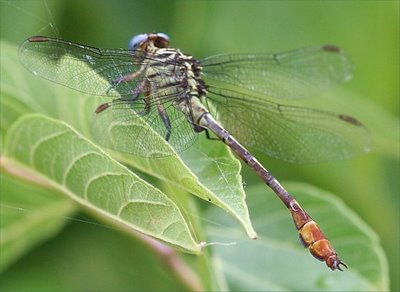 We obtained two for voucher specimens, including a female with a deformed wing (below); I have a state endangered species permit which allows me to collect these species. I also collected a Tule Bluet (Enallagma carunculatum) with a deformed abdomen. Anybody who has spent enough time looking at odonata will find some funky ones. I've been thinking lately they are worthwhile to submit to museum collections, in case one day they can be examined for genetic defects or environmental contaminants, although I suppose most deformities are caused by some mishap during emergence. In this case, the Detroit River isn't particularly pristine, and there is a chemical plants just on the northern border...which was emitting strong paint fume odors even on this Sunday afternoon.
We obtained two for voucher specimens, including a female with a deformed wing (below); I have a state endangered species permit which allows me to collect these species. I also collected a Tule Bluet (Enallagma carunculatum) with a deformed abdomen. Anybody who has spent enough time looking at odonata will find some funky ones. I've been thinking lately they are worthwhile to submit to museum collections, in case one day they can be examined for genetic defects or environmental contaminants, although I suppose most deformities are caused by some mishap during emergence. In this case, the Detroit River isn't particularly pristine, and there is a chemical plants just on the northern border...which was emitting strong paint fume odors even on this Sunday afternoon.
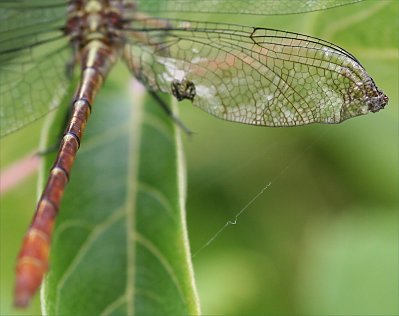 We also kicked up one or two other species of clubtails. One perched just out of net reach, and we were able to see it was indeed an Arrow Clubtail. Among the many Black Saddlebags and Common Green Darners were a handful of Aeshna darners; the ones we got looks at appeared to be Lance-tipped (A. constricta).
We also kicked up one or two other species of clubtails. One perched just out of net reach, and we were able to see it was indeed an Arrow Clubtail. Among the many Black Saddlebags and Common Green Darners were a handful of Aeshna darners; the ones we got looks at appeared to be Lance-tipped (A. constricta).
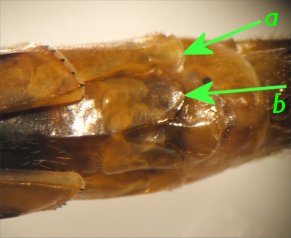 I was poking around some shrubs and saw a red-colored saddlebags land on a twig. Carolina Saddlebags (T. carolina) are typically not common in southeast Michigan, although some years are good for them. We've seen very few this year.
I was poking around some shrubs and saw a red-colored saddlebags land on a twig. Carolina Saddlebags (T. carolina) are typically not common in southeast Michigan, although some years are good for them. We've seen very few this year.
This one, however, turned out to be a Red Saddlebags (T. onusta), a new county record. There are only two specimens for the state, and one photo record from the county. Pennsylvania just had its first state Red Saddlebags, so they may be on the move this year.
Note in the poor photos that the subgenital plates of this female specimen (b) are as long as segment 9 (a). Also, the red coloration does not fill the anal loop of the hindwing, as it does in the Carolina Saddlebags. I've outlined part of the anal loop (like a drunk) in green in these photos. Red on top, Carolina on bottom.
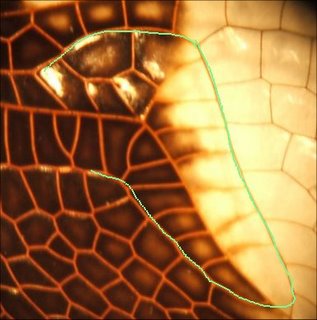
 In addition to Red Saddlebags and Striped Saddlebags, other interesting vagrants lately have been Band-winged Dragonlet (Erythrodiplax umbrata) on 11 August in Cincinnati, Ohio and Evening Skimmer (Tholymis citrina) in ~19 Aug in McCurtain Co., Oklahoma. We'll be out again next weekend!
In addition to Red Saddlebags and Striped Saddlebags, other interesting vagrants lately have been Band-winged Dragonlet (Erythrodiplax umbrata) on 11 August in Cincinnati, Ohio and Evening Skimmer (Tholymis citrina) in ~19 Aug in McCurtain Co., Oklahoma. We'll be out again next weekend!
 Once we got to the point along the southern edge of the brownfield where it was adjacent to the river, we started seeing Russet-tipped Clubtails. Stylurus, appropriately, found them first. We found at least two dozen prior to the rain starting again. Many were obligingly perched where they could be photographed:
Once we got to the point along the southern edge of the brownfield where it was adjacent to the river, we started seeing Russet-tipped Clubtails. Stylurus, appropriately, found them first. We found at least two dozen prior to the rain starting again. Many were obligingly perched where they could be photographed: We obtained two for voucher specimens, including a female with a deformed wing (below); I have a state endangered species permit which allows me to collect these species. I also collected a Tule Bluet (Enallagma carunculatum) with a deformed abdomen. Anybody who has spent enough time looking at odonata will find some funky ones. I've been thinking lately they are worthwhile to submit to museum collections, in case one day they can be examined for genetic defects or environmental contaminants, although I suppose most deformities are caused by some mishap during emergence. In this case, the Detroit River isn't particularly pristine, and there is a chemical plants just on the northern border...which was emitting strong paint fume odors even on this Sunday afternoon.
We obtained two for voucher specimens, including a female with a deformed wing (below); I have a state endangered species permit which allows me to collect these species. I also collected a Tule Bluet (Enallagma carunculatum) with a deformed abdomen. Anybody who has spent enough time looking at odonata will find some funky ones. I've been thinking lately they are worthwhile to submit to museum collections, in case one day they can be examined for genetic defects or environmental contaminants, although I suppose most deformities are caused by some mishap during emergence. In this case, the Detroit River isn't particularly pristine, and there is a chemical plants just on the northern border...which was emitting strong paint fume odors even on this Sunday afternoon. We also kicked up one or two other species of clubtails. One perched just out of net reach, and we were able to see it was indeed an Arrow Clubtail. Among the many Black Saddlebags and Common Green Darners were a handful of Aeshna darners; the ones we got looks at appeared to be Lance-tipped (A. constricta).
We also kicked up one or two other species of clubtails. One perched just out of net reach, and we were able to see it was indeed an Arrow Clubtail. Among the many Black Saddlebags and Common Green Darners were a handful of Aeshna darners; the ones we got looks at appeared to be Lance-tipped (A. constricta). I was poking around some shrubs and saw a red-colored saddlebags land on a twig. Carolina Saddlebags (T. carolina) are typically not common in southeast Michigan, although some years are good for them. We've seen very few this year.
I was poking around some shrubs and saw a red-colored saddlebags land on a twig. Carolina Saddlebags (T. carolina) are typically not common in southeast Michigan, although some years are good for them. We've seen very few this year.This one, however, turned out to be a Red Saddlebags (T. onusta), a new county record. There are only two specimens for the state, and one photo record from the county. Pennsylvania just had its first state Red Saddlebags, so they may be on the move this year.
Note in the poor photos that the subgenital plates of this female specimen (b) are as long as segment 9 (a). Also, the red coloration does not fill the anal loop of the hindwing, as it does in the Carolina Saddlebags. I've outlined part of the anal loop (like a drunk) in green in these photos. Red on top, Carolina on bottom.

 In addition to Red Saddlebags and Striped Saddlebags, other interesting vagrants lately have been Band-winged Dragonlet (Erythrodiplax umbrata) on 11 August in Cincinnati, Ohio and Evening Skimmer (Tholymis citrina) in ~19 Aug in McCurtain Co., Oklahoma. We'll be out again next weekend!
In addition to Red Saddlebags and Striped Saddlebags, other interesting vagrants lately have been Band-winged Dragonlet (Erythrodiplax umbrata) on 11 August in Cincinnati, Ohio and Evening Skimmer (Tholymis citrina) in ~19 Aug in McCurtain Co., Oklahoma. We'll be out again next weekend!
21 August 2006
New county record: Stripe-winged Baskettail
At the beginning of this field season, the first thing on our "to-do" list was to examine as many Common Baskettails, Epitheca cynosura, as we could find to see if some aren't actually Stripe-winged Baskettails, Epitheca costalis.
It wasn't a great year for Epithecas here, but I provided Nick (Thomas W.) Donnelly with several specimens. Nick is one of the premier odonatologists in the U.S., and a founding member of the Dragonfly Societies of the Americas. He works a lot on teasing out relationships between geographic races, subspecies, and populations of odonata that may in fact be new species or intergrades. He has a particular interest in Enallagma cyathigerum/vernale (Northern/"Vernal" Bluets), Sympetrum rubicundulum/internum/janae, (Ruby/Cherry-faced/Jane's Meadowhawks) Amphiagrion saucium/abbreviatum (Eastern/Western Red Damsels), and, Epithecas of various types.
The verdict is in: I had two cynosura males, one intermediate male, and a costalis female. Below, I provide a few photos I too, through the microscope of the terminal appendages of the female.
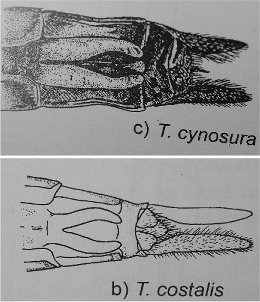 Reference diagrams from Needham, Westfall, and May (2000) of the undersides of female Epithecas (Tetragoneuria).
Reference diagrams from Needham, Westfall, and May (2000) of the undersides of female Epithecas (Tetragoneuria).
E. cynosura (Common Baskettail)
Below, a female Epitheca from Wayne Co., MI, 29 May 2006. Specimen in acetone several hours before photos taken. Female was quite fresh, and had tinted wing tips. Nick Donnellly confirms this is E. costalis.
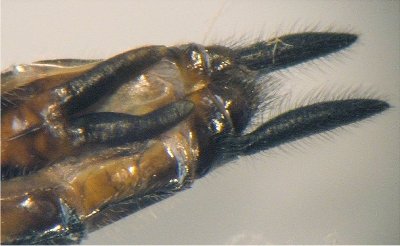
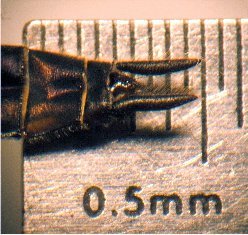
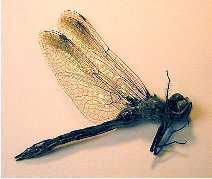
It wasn't a great year for Epithecas here, but I provided Nick (Thomas W.) Donnelly with several specimens. Nick is one of the premier odonatologists in the U.S., and a founding member of the Dragonfly Societies of the Americas. He works a lot on teasing out relationships between geographic races, subspecies, and populations of odonata that may in fact be new species or intergrades. He has a particular interest in Enallagma cyathigerum/vernale (Northern/"Vernal" Bluets), Sympetrum rubicundulum/internum/janae, (Ruby/Cherry-faced/Jane's Meadowhawks) Amphiagrion saucium/abbreviatum (Eastern/Western Red Damsels), and, Epithecas of various types.
The verdict is in: I had two cynosura males, one intermediate male, and a costalis female. Below, I provide a few photos I too, through the microscope of the terminal appendages of the female.
 Reference diagrams from Needham, Westfall, and May (2000) of the undersides of female Epithecas (Tetragoneuria).
Reference diagrams from Needham, Westfall, and May (2000) of the undersides of female Epithecas (Tetragoneuria).E. cynosura (Common Baskettail)
Below, a female Epitheca from Wayne Co., MI, 29 May 2006. Specimen in acetone several hours before photos taken. Female was quite fresh, and had tinted wing tips. Nick Donnellly confirms this is E. costalis.



16 August 2006
A little "up north" field work
Last weekend, the Urban Dragon Hunters left the urban jungle for up north. In Michigan, "up north" is usually anything north of a line extending through the middle of the Lower Peninsula. We went to the northeast part of the state, hosted by Fancy Footwork Fred, new to odonata hunting. He has a great eye, but his technique needs a little refining. It involves a lot of scrambling, fast feints, and urgent whooshing swings versus a little patient stalking. Hey, we were all there once. I think we'll call him Pachydiplax, in honor of the Blue Dasher.
Probably our best find was Mocha Emerald (Somatochlora linearis), a new county record and one of a handful in the state. Another example of how little we know about the distribution of this species (last encounter is here). The only other emerald I've caught in Michigan is Brush-tipped (S. walshii), and we found a couple of those, too. New for us was Williamson's Emerald (S. williamsoni), which we unexpectedly found at a creek crossing on a pretty busy road.
We had four species of mosaic darner, which are always fun. They all look the same on the wing, and there is always a sense of anticipation once you net one and examine the combination of facial colors and the shape of the thoracic stripes and cerci to see what you've got. Lance-tipped Darner (Aeshna constricta) was the most common, as it is around here. Here is a green-from female we netted and released.
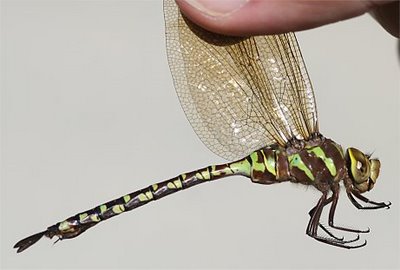 Canada Darner (A. canadensis) was also common.
Canada Darner (A. canadensis) was also common.
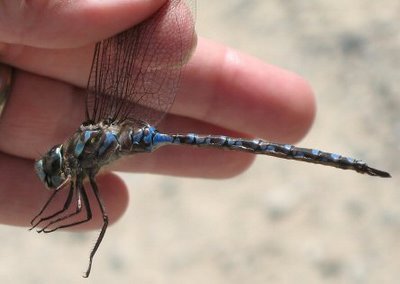 We had one Black-tipped Darner (A. tuberculifera, what a cool name). Our other new ode was a Lake Darner (A. eremita), a county record. Here she is:
We had one Black-tipped Darner (A. tuberculifera, what a cool name). Our other new ode was a Lake Darner (A. eremita), a county record. Here she is:
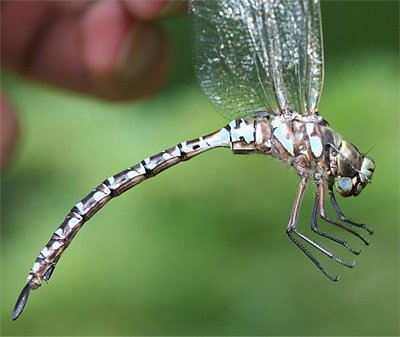 We were very surprised at how few damselfies we found -- species and individuals. As usual, Eastern Forktails (Ischnura verticalis) were most common. I found this dainty female having a lacewing for breakfast. Even the most delicate odonata are feared predators!
We were very surprised at how few damselfies we found -- species and individuals. As usual, Eastern Forktails (Ischnura verticalis) were most common. I found this dainty female having a lacewing for breakfast. Even the most delicate odonata are feared predators!
 We ended up seeing 35 species and alas, the weekend was all too short. Summer is slipping away.
We ended up seeing 35 species and alas, the weekend was all too short. Summer is slipping away.
Probably our best find was Mocha Emerald (Somatochlora linearis), a new county record and one of a handful in the state. Another example of how little we know about the distribution of this species (last encounter is here). The only other emerald I've caught in Michigan is Brush-tipped (S. walshii), and we found a couple of those, too. New for us was Williamson's Emerald (S. williamsoni), which we unexpectedly found at a creek crossing on a pretty busy road.
We had four species of mosaic darner, which are always fun. They all look the same on the wing, and there is always a sense of anticipation once you net one and examine the combination of facial colors and the shape of the thoracic stripes and cerci to see what you've got. Lance-tipped Darner (Aeshna constricta) was the most common, as it is around here. Here is a green-from female we netted and released.
 Canada Darner (A. canadensis) was also common.
Canada Darner (A. canadensis) was also common. We had one Black-tipped Darner (A. tuberculifera, what a cool name). Our other new ode was a Lake Darner (A. eremita), a county record. Here she is:
We had one Black-tipped Darner (A. tuberculifera, what a cool name). Our other new ode was a Lake Darner (A. eremita), a county record. Here she is: We were very surprised at how few damselfies we found -- species and individuals. As usual, Eastern Forktails (Ischnura verticalis) were most common. I found this dainty female having a lacewing for breakfast. Even the most delicate odonata are feared predators!
We were very surprised at how few damselfies we found -- species and individuals. As usual, Eastern Forktails (Ischnura verticalis) were most common. I found this dainty female having a lacewing for breakfast. Even the most delicate odonata are feared predators! We ended up seeing 35 species and alas, the weekend was all too short. Summer is slipping away.
We ended up seeing 35 species and alas, the weekend was all too short. Summer is slipping away.
08 August 2006
!Fragile Forktail!
Fragile Forktails (Ischnura posita) are not really worthy of an exclamation point, except that this punctuation mark appears on the thorax. Usually the markings are pale green, but females and immature males are blue, like this one I saw a couple weeks ago:
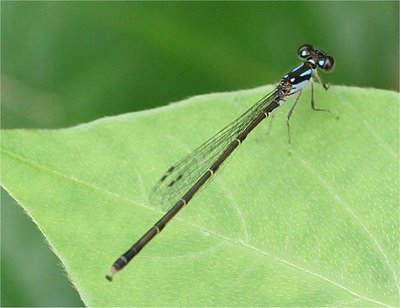 Stylurus and I went to a new wetland area adjacent to one of the local rivers. Considering the very hot weather we had a couple weeks ago, we sort of expected some Aeshnas to be out and about, but we saw none. Our most notable find was a single female American Rubyspot (Hetaerina americana) along the river. This is a particularly flashy, silty, pretty polluted river, and we've never seen a rubyspot along any of its branches or tributaries. The next day I read that a 500,000 square-foot shopping center will be built nearby. There goes the neighborhood.
Stylurus and I went to a new wetland area adjacent to one of the local rivers. Considering the very hot weather we had a couple weeks ago, we sort of expected some Aeshnas to be out and about, but we saw none. Our most notable find was a single female American Rubyspot (Hetaerina americana) along the river. This is a particularly flashy, silty, pretty polluted river, and we've never seen a rubyspot along any of its branches or tributaries. The next day I read that a 500,000 square-foot shopping center will be built nearby. There goes the neighborhood.
 Stylurus and I went to a new wetland area adjacent to one of the local rivers. Considering the very hot weather we had a couple weeks ago, we sort of expected some Aeshnas to be out and about, but we saw none. Our most notable find was a single female American Rubyspot (Hetaerina americana) along the river. This is a particularly flashy, silty, pretty polluted river, and we've never seen a rubyspot along any of its branches or tributaries. The next day I read that a 500,000 square-foot shopping center will be built nearby. There goes the neighborhood.
Stylurus and I went to a new wetland area adjacent to one of the local rivers. Considering the very hot weather we had a couple weeks ago, we sort of expected some Aeshnas to be out and about, but we saw none. Our most notable find was a single female American Rubyspot (Hetaerina americana) along the river. This is a particularly flashy, silty, pretty polluted river, and we've never seen a rubyspot along any of its branches or tributaries. The next day I read that a 500,000 square-foot shopping center will be built nearby. There goes the neighborhood.
02 July 2006
Thanks a bunch
Bryan Pfeiffer, editor of the Boghaunter, helpfully sends along this photo of one of his encounters with Anax longipes.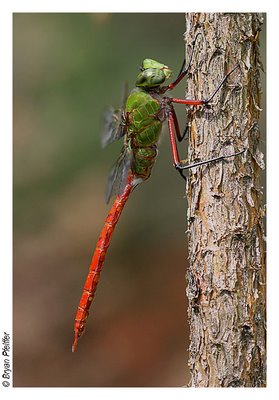 Eh, lucky bastard.
Eh, lucky bastard.
 Eh, lucky bastard.
Eh, lucky bastard.
01 July 2006
Comet Darner 4, Urban Dragon Hunters 0
Things have not been quite as rosy since the score with the Variegated Meadowhawk. As is my habit, I check the retention ponds in all the new subdivisions I happen upon. (Why they are still building houses in a county with the highest foreclosure rate in the country, I'm not sure, but they are.) Lately I have been doing bird surveys in some of the older and more heavily developed working-class suburbs more or less in the center of the county. As I was scanning a new pond in Taylor, our old nemesis, the Comet Darner, Anax longipes, cruised by, chasing one of the many usual pond skimmers. I watched it for some time before deciding it was spending just enough time near the edges of the pond that it might be worthwhile for me to fetch my net. Nearly an hour of patience yielded only two passes worthy of a swing, which were unproductive.
I did record 16 species of odonata in this lousy pond, including Marsh Bluet, Enallagma ebrium, a species which we've only found in one other (retention) pond, which was the first county record since 1904. I later researched this area and found out this pond was once surrounded by woods. While this may have contributed to its diversity, it had clearly been scoured out and drains put in, etc. Depressing. Stylurus and I returned today, but no longipes. If you are keeping count -- and we are -- this is the fourth location we have seen this species and been unable to catch one to voucher it for the county.
In yet another carved-out subdivision last weekend, this one in Belleville, we watched that blue-eyed beauty the Spatterdock Darner, Rhionaeschna mutata, circle an especially mucky and scummy retention pond. This species is usually found in wooded ponds with spatterdock, and we think it came from a pond a few miles away which we can see enticingly from a bridge, but can't access. The pond is midway between this site and one of our favorite metropark sites where we have seen Rhionaeschna before. And this pond did have woods nearby (now partly destroyed). It stayed mostly over the water, and when it did venture close to us, we missed. Yesterday we went back, and it wasn't around. We may as well begin a tally on this one: Spatterdock Darner 2, Urban Dragon Hunters 0.
Back in Taylor today, after our failed Anax longipes search, we went to a nearby municipal park. A retention pond was created to the right of the big field with the star in it on the map below, but there wasn't much there. As you can see, this area is highly urbanized.
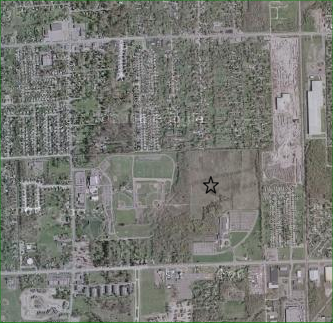 As we were leaving the field (we'd been hoping to catch some Sympetrum for a study being done by Nick Donnelly; we saw none), a brownish ode caught our attention. After several passes, Stylurus was able to nab it. To our great surprise, it was a Mocha Emerald, Somatochlora linearis. The only other county record was one I caught at Lower Huron Metropark in 2001. While it is often the most common emerald where it is found, there are only a handful of specimens for the state. Look again at the aerial photo; we caught it at the edge of this field where the star is. These are odes of wooded streams. There might be a ditched creek on the north side of the park, but really, where did this come from? I think it illustrates, once again, that you can find interesting odes in uninteresting, unexpected places.
As we were leaving the field (we'd been hoping to catch some Sympetrum for a study being done by Nick Donnelly; we saw none), a brownish ode caught our attention. After several passes, Stylurus was able to nab it. To our great surprise, it was a Mocha Emerald, Somatochlora linearis. The only other county record was one I caught at Lower Huron Metropark in 2001. While it is often the most common emerald where it is found, there are only a handful of specimens for the state. Look again at the aerial photo; we caught it at the edge of this field where the star is. These are odes of wooded streams. There might be a ditched creek on the north side of the park, but really, where did this come from? I think it illustrates, once again, that you can find interesting odes in uninteresting, unexpected places.
I did record 16 species of odonata in this lousy pond, including Marsh Bluet, Enallagma ebrium, a species which we've only found in one other (retention) pond, which was the first county record since 1904. I later researched this area and found out this pond was once surrounded by woods. While this may have contributed to its diversity, it had clearly been scoured out and drains put in, etc. Depressing. Stylurus and I returned today, but no longipes. If you are keeping count -- and we are -- this is the fourth location we have seen this species and been unable to catch one to voucher it for the county.
In yet another carved-out subdivision last weekend, this one in Belleville, we watched that blue-eyed beauty the Spatterdock Darner, Rhionaeschna mutata, circle an especially mucky and scummy retention pond. This species is usually found in wooded ponds with spatterdock, and we think it came from a pond a few miles away which we can see enticingly from a bridge, but can't access. The pond is midway between this site and one of our favorite metropark sites where we have seen Rhionaeschna before. And this pond did have woods nearby (now partly destroyed). It stayed mostly over the water, and when it did venture close to us, we missed. Yesterday we went back, and it wasn't around. We may as well begin a tally on this one: Spatterdock Darner 2, Urban Dragon Hunters 0.
Back in Taylor today, after our failed Anax longipes search, we went to a nearby municipal park. A retention pond was created to the right of the big field with the star in it on the map below, but there wasn't much there. As you can see, this area is highly urbanized.
 As we were leaving the field (we'd been hoping to catch some Sympetrum for a study being done by Nick Donnelly; we saw none), a brownish ode caught our attention. After several passes, Stylurus was able to nab it. To our great surprise, it was a Mocha Emerald, Somatochlora linearis. The only other county record was one I caught at Lower Huron Metropark in 2001. While it is often the most common emerald where it is found, there are only a handful of specimens for the state. Look again at the aerial photo; we caught it at the edge of this field where the star is. These are odes of wooded streams. There might be a ditched creek on the north side of the park, but really, where did this come from? I think it illustrates, once again, that you can find interesting odes in uninteresting, unexpected places.
As we were leaving the field (we'd been hoping to catch some Sympetrum for a study being done by Nick Donnelly; we saw none), a brownish ode caught our attention. After several passes, Stylurus was able to nab it. To our great surprise, it was a Mocha Emerald, Somatochlora linearis. The only other county record was one I caught at Lower Huron Metropark in 2001. While it is often the most common emerald where it is found, there are only a handful of specimens for the state. Look again at the aerial photo; we caught it at the edge of this field where the star is. These are odes of wooded streams. There might be a ditched creek on the north side of the park, but really, where did this come from? I think it illustrates, once again, that you can find interesting odes in uninteresting, unexpected places.
16 June 2006
Variegated Meadowhawk: Last seen in 1931
Yesterday I was out in the field, doing a bird survey near our big metropolitan airport on a largish plot of vacant land, happily without any "no trespassing" signs. It was mostly scrubby -- old farmland -- with some woodland border. I was not carrying a net, camera, or even my bug binos. After I had wandered nearly as far from my car as I could go, I came to a spot with deep mud-filled ruts. The margins had a lot of horsetail, some spots had a few cattails and other aquatic plants. Off-roading is apparently most fun when you can get muddy and rip up vegetation most effectively.
I flushed a few teneral meadowhawks (Sympetrum sp.), this seemed like it might be on the cusp of being early. They were just old enough that I couldn't catch them by hand, and I wasn't even wearing a ball cap, which would have worked. There were also some pretty little spreadwings around, later identified as mostly Lyre-tipped (Lestes unguiculatus) with a few Emeralds thrown in (L. dryas). As I was perusing them, another meadowhawk caught my eye. A half-size larger than the others, the abdomen lined with pale spots bordered in black.
 Variegated Meadowhawk (S. corruptum)! We've been looking for this species for years, and it is more common in the western half of the U.S., and usually only appears here as a late-summer vagrant, as they are strongly migratory. There are 41 specimens in Michigan, and only two records for Wayne County: one from 1926 and the other from 1931.
Variegated Meadowhawk (S. corruptum)! We've been looking for this species for years, and it is more common in the western half of the U.S., and usually only appears here as a late-summer vagrant, as they are strongly migratory. There are 41 specimens in Michigan, and only two records for Wayne County: one from 1926 and the other from 1931.
This find necessitated a long trek back to the car for my gear and a return trip. It didn't take me long to relocate "the" meadowhawk, which I secured after a short pursuit. After I soon discovered that while the other species (later found to be Ruby, S. rubicundulum) were the most numerous, I was able to flush quite a few corruptums. Many were only hours old, they were clearly emerging along with the others. Last fall there must have been one or more vagrants in the area that laid eggs in this damp, scrubby field. The photo above isn't the best, but it was taken with my regular lens...the macro is in the shop after the involuntary dunking episode.
Of the 91 species recorded for the county, there are now only 11 which we have not found; I think only perhaps half of them probably still exist in the county. Another serendipitous find!
I flushed a few teneral meadowhawks (Sympetrum sp.), this seemed like it might be on the cusp of being early. They were just old enough that I couldn't catch them by hand, and I wasn't even wearing a ball cap, which would have worked. There were also some pretty little spreadwings around, later identified as mostly Lyre-tipped (Lestes unguiculatus) with a few Emeralds thrown in (L. dryas). As I was perusing them, another meadowhawk caught my eye. A half-size larger than the others, the abdomen lined with pale spots bordered in black.
 Variegated Meadowhawk (S. corruptum)! We've been looking for this species for years, and it is more common in the western half of the U.S., and usually only appears here as a late-summer vagrant, as they are strongly migratory. There are 41 specimens in Michigan, and only two records for Wayne County: one from 1926 and the other from 1931.
Variegated Meadowhawk (S. corruptum)! We've been looking for this species for years, and it is more common in the western half of the U.S., and usually only appears here as a late-summer vagrant, as they are strongly migratory. There are 41 specimens in Michigan, and only two records for Wayne County: one from 1926 and the other from 1931.This find necessitated a long trek back to the car for my gear and a return trip. It didn't take me long to relocate "the" meadowhawk, which I secured after a short pursuit. After I soon discovered that while the other species (later found to be Ruby, S. rubicundulum) were the most numerous, I was able to flush quite a few corruptums. Many were only hours old, they were clearly emerging along with the others. Last fall there must have been one or more vagrants in the area that laid eggs in this damp, scrubby field. The photo above isn't the best, but it was taken with my regular lens...the macro is in the shop after the involuntary dunking episode.
Of the 91 species recorded for the county, there are now only 11 which we have not found; I think only perhaps half of them probably still exist in the county. Another serendipitous find!
13 June 2006
DSA 2006, Day 2
Yes, I would have updated a couple days ago with photos and a field trip report, but I managed to submerse myself in a river -- twice -- camera, cell phone, and all. Remarkably, the body of my Canon Digital Rebel XT did not take on any water (the lens is another matter) and works fine. But I didn't want to give it a try until I was sure no damage had been done. Moving right along...
Stylurus and I spent the day at several locations along the Little Barren River, south branch shown below, near where the east, south, and main forks come together.
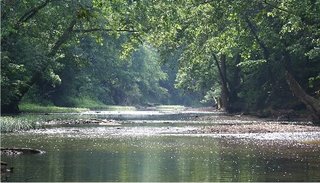 I can't think of a better way to spend a day than walking along a beautiful river, cool water at your feet, hot sun through the trees, especially when being serenaded by Louisiana Waterthrush, Acadian Flycatchers, Summer Tanagers, and Kentucky Warblers.
I can't think of a better way to spend a day than walking along a beautiful river, cool water at your feet, hot sun through the trees, especially when being serenaded by Louisiana Waterthrush, Acadian Flycatchers, Summer Tanagers, and Kentucky Warblers.
We chose river locations in order to see some interesting gomphids. This location featured an old friend from home, the Black-shouldered Spinylegs (Dromogomphus spinosus). They were all over.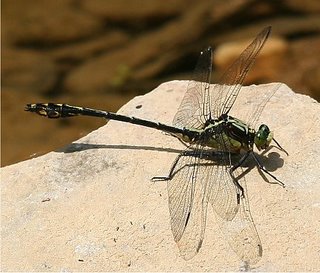
The substrate at this location was both sandy and rocky, and we decided to check out a more riffly, rocky area of the south fork. At the tops of most riffles there was a good-sized gomphid, which reminded me in flight of an Arrow Clubtail (Stylurus spiniceps). They were, however, Handsome Clubtails (Gomphus crassus), a species new to us which does not occur in Michigan.
At one point, Stylurus saw a crassus grab a small gomphid which he had just seen land on a flat rock: a least clubtail, Stylogomphus sp. I parked myself by the flat rock and waited. I was finally rewarded when a tiny, delicate clubtail perched briefly before going after a small insect. This was Stylogomphus sigmastylus, the Interior Least Clubtail, split from S. albistylus (now Eastern Least Clubtail) in 2004 by Ellis Laudermilk and Carl Cook, our DSA 2006 hosts. While both species occur in Kentucky (with hybrids) and can only be distinguished in hand, apparently all that were examined were S. sigmastylus, so I will presume that's what we saw. Hey, this is just my personal trip list. If I were being official, I'd have to net one.
Although we had no chances to catch a Stylogomphus, after many attempts we finally netted a Handsome Clubtail to take a look. I hadn't had many good opportunities, and eventually I made what I thought was a perfect swing. Stylurus was watching, and told me I narrowly missed. "Really?" I exclaimed, "I was sure I had it!" A minute later, after moving upstream, I heard a rustling in my net -- I had caught it. It was indeed handsome in the hand, and we let it go to annoy other people.
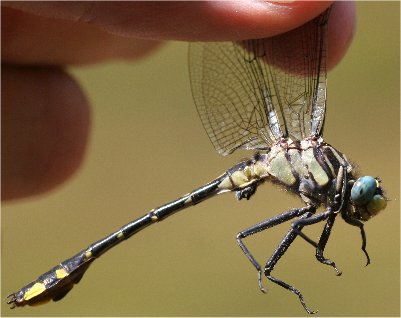 One of the coolest odes you are likely to see in the U.S. is the Dragonhunter (Hagenius brevistylus). Stylurus had seen one in Lenawee Co. in Michigan, but I missed it. There was at least one patrolling the Little Barren, and we located it perched on a twig, low over the water. My photos are from behind, and so do not do it proper justice. After John Abbott took some photos, it lumbered off towards Stylurus, who netted it. Holy buckets! This was the only dragonfly I've ever held onto which was actually hefty. The wing veins were as thick as some odonata legs, and the legs were as thick as toothpicks. This was one impressive bug. We released him to terrorize every other dragonfly on his stretch of the river. Be sure to click on his photo, below, to check him out in detail.
One of the coolest odes you are likely to see in the U.S. is the Dragonhunter (Hagenius brevistylus). Stylurus had seen one in Lenawee Co. in Michigan, but I missed it. There was at least one patrolling the Little Barren, and we located it perched on a twig, low over the water. My photos are from behind, and so do not do it proper justice. After John Abbott took some photos, it lumbered off towards Stylurus, who netted it. Holy buckets! This was the only dragonfly I've ever held onto which was actually hefty. The wing veins were as thick as some odonata legs, and the legs were as thick as toothpicks. This was one impressive bug. We released him to terrorize every other dragonfly on his stretch of the river. Be sure to click on his photo, below, to check him out in detail.
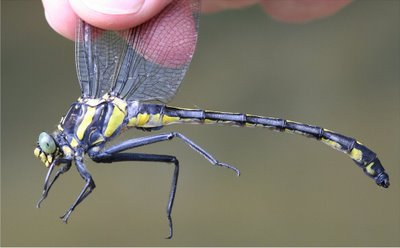
It was shortly after this that I slid on an algae-covered rock and "cooled off." It was late afternoon at this time, so we headed back to the hotel to dry off the electronics and change for the group BBQ at Sulphur Well, which was fun even though it was in a dry county. We were hoping to see some shadowdragons (Neurocordulia sp.) at dusk, but alas it began to thunder and rain just before that time. We had to say our goodbyes; although there would be one more day of field trips, we had to head home.
We really look forward to going to other odonata meetings -- the programs were informative, we learned a lot from the many great, friendly experts we met, and having precise guidance on where the odes were in a strange state was a ton of fun. Next year's DSA is in Arizona...
Stylurus and I spent the day at several locations along the Little Barren River, south branch shown below, near where the east, south, and main forks come together.
 I can't think of a better way to spend a day than walking along a beautiful river, cool water at your feet, hot sun through the trees, especially when being serenaded by Louisiana Waterthrush, Acadian Flycatchers, Summer Tanagers, and Kentucky Warblers.
I can't think of a better way to spend a day than walking along a beautiful river, cool water at your feet, hot sun through the trees, especially when being serenaded by Louisiana Waterthrush, Acadian Flycatchers, Summer Tanagers, and Kentucky Warblers.We chose river locations in order to see some interesting gomphids. This location featured an old friend from home, the Black-shouldered Spinylegs (Dromogomphus spinosus). They were all over.

The substrate at this location was both sandy and rocky, and we decided to check out a more riffly, rocky area of the south fork. At the tops of most riffles there was a good-sized gomphid, which reminded me in flight of an Arrow Clubtail (Stylurus spiniceps). They were, however, Handsome Clubtails (Gomphus crassus), a species new to us which does not occur in Michigan.
At one point, Stylurus saw a crassus grab a small gomphid which he had just seen land on a flat rock: a least clubtail, Stylogomphus sp. I parked myself by the flat rock and waited. I was finally rewarded when a tiny, delicate clubtail perched briefly before going after a small insect. This was Stylogomphus sigmastylus, the Interior Least Clubtail, split from S. albistylus (now Eastern Least Clubtail) in 2004 by Ellis Laudermilk and Carl Cook, our DSA 2006 hosts. While both species occur in Kentucky (with hybrids) and can only be distinguished in hand, apparently all that were examined were S. sigmastylus, so I will presume that's what we saw. Hey, this is just my personal trip list. If I were being official, I'd have to net one.
Although we had no chances to catch a Stylogomphus, after many attempts we finally netted a Handsome Clubtail to take a look. I hadn't had many good opportunities, and eventually I made what I thought was a perfect swing. Stylurus was watching, and told me I narrowly missed. "Really?" I exclaimed, "I was sure I had it!" A minute later, after moving upstream, I heard a rustling in my net -- I had caught it. It was indeed handsome in the hand, and we let it go to annoy other people.
 One of the coolest odes you are likely to see in the U.S. is the Dragonhunter (Hagenius brevistylus). Stylurus had seen one in Lenawee Co. in Michigan, but I missed it. There was at least one patrolling the Little Barren, and we located it perched on a twig, low over the water. My photos are from behind, and so do not do it proper justice. After John Abbott took some photos, it lumbered off towards Stylurus, who netted it. Holy buckets! This was the only dragonfly I've ever held onto which was actually hefty. The wing veins were as thick as some odonata legs, and the legs were as thick as toothpicks. This was one impressive bug. We released him to terrorize every other dragonfly on his stretch of the river. Be sure to click on his photo, below, to check him out in detail.
One of the coolest odes you are likely to see in the U.S. is the Dragonhunter (Hagenius brevistylus). Stylurus had seen one in Lenawee Co. in Michigan, but I missed it. There was at least one patrolling the Little Barren, and we located it perched on a twig, low over the water. My photos are from behind, and so do not do it proper justice. After John Abbott took some photos, it lumbered off towards Stylurus, who netted it. Holy buckets! This was the only dragonfly I've ever held onto which was actually hefty. The wing veins were as thick as some odonata legs, and the legs were as thick as toothpicks. This was one impressive bug. We released him to terrorize every other dragonfly on his stretch of the river. Be sure to click on his photo, below, to check him out in detail.
It was shortly after this that I slid on an algae-covered rock and "cooled off." It was late afternoon at this time, so we headed back to the hotel to dry off the electronics and change for the group BBQ at Sulphur Well, which was fun even though it was in a dry county. We were hoping to see some shadowdragons (Neurocordulia sp.) at dusk, but alas it began to thunder and rain just before that time. We had to say our goodbyes; although there would be one more day of field trips, we had to head home.
We really look forward to going to other odonata meetings -- the programs were informative, we learned a lot from the many great, friendly experts we met, and having precise guidance on where the odes were in a strange state was a ton of fun. Next year's DSA is in Arizona...
10 June 2006
DSA 2006, Day 1
Greetings from beautiful central Kentucky, where Stylurus and I are attending the 2006 annual meeting of the Dragonfly Society of the Americans. The meeting location is in Cave City, just outside Mammoth Cave National Park. There are about 60 people here from many states, and it’s already been fun to meet odonata experts that I’ve corresponded with in the past, especially Ellis Laudermilk of the Kentucky State Natural Preseves Commission; Dennis Paulson, recently retired from the University of Puget Sound, and an expert on Neotropical odonata; Bob Glotzhober and Dave McShaffrey, of the Ohio Odonata Survey and authors of a great book on Ohio odonata; Ed Lam, the author and illustrator of stunning The Damselflies of the Northeast, the best example of the intersection between art and science that I can think of; and Nick Donnelly, longtime odonata researcher.
Today after the business meeting we heard four papers:
Tomorrow: Field trips. The Little Barren River is nearby, and the list includes boatloads of gomphids. Hopefully, the weather will cooperate and we will get a few nifty pictures.
Today after the business meeting we heard four papers:
- Utilizing citizen science to study the odonates of the Great Smoky Mountains National Park
- Reversible temperature-dependent color change in Anax junius
- What is a species? Odonate problems involving hybrids, intergrades, subspecies and plain old variation
- Molecular phylogeny of the Libelloidea
Tomorrow: Field trips. The Little Barren River is nearby, and the list includes boatloads of gomphids. Hopefully, the weather will cooperate and we will get a few nifty pictures.
11 May 2006
Lancet Clubtail kicks off for the season
I've only spent a tiny amount of time in the field, but really haven't seen squat yet. However, yesterday, Stylurus brought home a teneral female Lancet Clubtail, Gomphus exilis, from Oakland Co. This is the earliest record for an adult in the state by 9 days. This boring little ode (sorry, but they are really very dull) is one of the earliest odes to emerge in spring. We've had them before in Wayne County as well.
10 May 2006
Dragonfly migration, part 1
The British newspaper The Telegraph reports on a study published in Biology Letters, where migrating dragonflies were tracked in fall migration along the U.S. Atlantic coast using small transmitters and airplanes. Turns out odonata use similar cues and strategies as birds during migration. One green darner, nicknamed Dave, traveled 100 miles in a single day (Dave's route shown in this map from the Telegraph article. The paper abstract is below. VERY COOL!
Wikelski, M., D. Moskowitz, J. S. Adelman, J. Cochran, D. S. Wilcove, M. L. May. 2006. Simple rules guide dragonfly migration. Biology Letters (early online).
Dragonfly migration, part 2 will be awhile in coming, but I have started writing a post describing what we know about migration in odonata. The use of radio transmitters is obviously promising, but also, if one has to use planes, prohibitively expensive.
*58 km = 36 miles.Every year billions of butterflies, dragonflies, moths and other insects migrate across continents, and considerable progress has been made in understanding population-level migratory phenomena. However, little is known about destinations and strategies of individual insects. We attached miniaturized radio transmitters (ca 300mg) to the thoraxes of 14 individual dragonflies (common green darners, Anax junius) and followed them during their autumn migration for up to 12 days, using receiver-equipped Cessna airplanes and ground teams. Green darners exhibited distinct stopover and migration days. On average, they migrated every 2.9±0.3 days, and their average net advance was 58*±11km in 6.1±0.9 days (11.9±2.8kmd−1) in a generally southward direction (186±52°). They migrated exclusively during the daytime, when wind speeds were less than 25kmh−1, regardless of wind direction, but only after two nights of successively lower temperatures (decrease of 2.1±0.6°C in minimum temperature). The migratory patterns and apparent decision rules of green darners are strikingly similar to those proposed for songbirds, and may represent a general migration strategy for long-distance migration of organisms with high self-propelled flight speeds.
Wikelski, M., D. Moskowitz, J. S. Adelman, J. Cochran, D. S. Wilcove, M. L. May. 2006. Simple rules guide dragonfly migration. Biology Letters (early online).
Dragonfly migration, part 2 will be awhile in coming, but I have started writing a post describing what we know about migration in odonata. The use of radio transmitters is obviously promising, but also, if one has to use planes, prohibitively expensive.
02 May 2006
Odonata goals for 2006
Time to record for posterity and future reference the goals the Urban Dragon Hunters hope to accomplish this field season.
- Examine lots of Common Baskettails, Epitheca cynosura, to see if some aren't actually Stripe-winged Baskettails, Epitheca costalis. There are a few records of E. costalis for Michigan, as well as some cynosura/costalis intergrades. You can read about this interesting situation in a past issue of the Williamsonia (pdf).
- Does Southern Spreadwing (Lestes disjunctus australis) really occur in Wayne County? There are about a dozen specimens for the state, but none for Wayne Co., although there is an old published record. I've been looking for them, to no avail so far. Likewise Hagen's Bluet (Enallagma hageni). Could be that these records are in error.
- Search some more for Turquoise Bluet, Enallagma divagans. A fairly recent published record exists for the county. Same for Spatterdock Darner (Aeshna mutata) and Four-spotted Skimmer (Libellula quadrimaculata).
- There are records here for Canada Darner (Aeshna canadensis) and Mottled Darner (A. clepsydra), but they are from prior to 1880. Methinks they are no longer around these parts. A similar old record exists for Lilypad Clubtail (Arigomphus furcifer), but I think this might be findable.
- Variegated Meadowhawk (Sympetrum corruptum) is a vagrant, and I'm hopeful it'll show up in the county again soon.
- New species that the Hunters feel should be found in the county include Lilypad Forktail (Ischnura kellicotti), Spangled Skimmer, (Libellula cyanea), and Black-shouldered Spinyleg (Dromogomphus spinosus). For the most part, the new county records we've obtained have been species that we were not looking for and did not expect, so who knows what we'll find!
- Get better photos of Nannothemis and Stylurus for the sidebar!
02 February 2006
Some tropical lepidoptera

The Malachite (Siproeta stelenes) is a classic butterfly of the tropics, found from south Florida and south Texas through Brazil. With a 9 cm wingspan, and brilliant green coloration, it's hard to miss. The upperside is kelly green and black, in a pattern reminiscent of a swallowtail. I kind of prefer the more subtle patterning on the underside of the wings.
Adults feed mostly on rotting fruit, sometimes nectar and dung, and are found along forest edges and openings, including disturbed areas. Among the larval host plants is ruellia and shrimp plant (Blechum brownei). The latter, a non-native ornamental considered an invasive weed, has probably helped this butterfly spread in the southern U.S., or at least Florida, after the insect arrived, presumably from Cuba, sometime in the 1960s. La Belen Preserve, Najasa, Camaguey Province, Cuba.
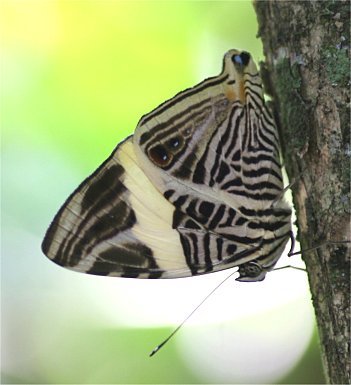 Colobura dirce, sometimes called The Mosiac, is seen here in its characteristic head-down pose, which it strikes after an erratic pell-mell flight through shady forests throughout the Greater Antilles and Mexico south to Argentina. Larva feed on Cecropia, a familiar tropical pioneer tree species. Colobura is much cooler looking in this posture; the uppersides of the wings are plain brown with a cream-colored stripe. Rio Hatiguanico, Zapata Swamp, Matanzas Province, Cuba.
Colobura dirce, sometimes called The Mosiac, is seen here in its characteristic head-down pose, which it strikes after an erratic pell-mell flight through shady forests throughout the Greater Antilles and Mexico south to Argentina. Larva feed on Cecropia, a familiar tropical pioneer tree species. Colobura is much cooler looking in this posture; the uppersides of the wings are plain brown with a cream-colored stripe. Rio Hatiguanico, Zapata Swamp, Matanzas Province, Cuba.The Mercurial Skipper (Proteides mercurius) is a large skipper with a gorgeous subtle pattern on the underwings, and a glowing orange head and body. It would seem to be hard to miss, but is reported to be secretive. It can be found in the southern U.S. and the Greater Antilles. This particular subspecies, P. m. sanantonio, is endemic to Cuba. Palpite, Matanzas Province, Cuba.

The Pale Cracker (Hamadryas amphichloe) is in a family named so because the wings can make an audible "clicking" sound. This species, found from Mexico to Peru and on the larger West Indian islands, may be silent. Sierra Cubitas mountains, Camaguey Province, Cuba.
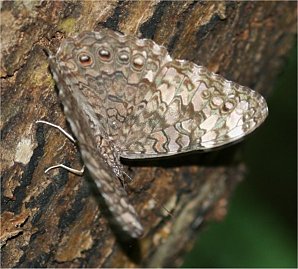
05 January 2006
Bias in butterfly monitoring
I read an interesting paper in the journal Biological Conservation regarding bias involved in detecting various species of butterflies in standardized monitoring schemes. This bias, of course, can lead to misleading comparisons of populations of different species. The study, which took place in Great Britain, found several biases.
Dennis, R.L.H., T.G. Shreeve, N.J.B. Isaac, D.B. Roy, P.B. Hardy, R. Fox and J. Asher. 2006. The effects of visual apparency on bias in butterfly recording and monitoring. Biological Conservation 128:486-492.
butterflies
insects
- The larger and more apparent butterfly species are, and the longer flight periods and wider distributions they have, the earlier is their first discovery date.
- Abundance measures on the national project Butterflies for the New Millennium are higher for larger butterflies and lower for butterflies that are active on higher vegetation substrates (versus, say, ones that fly closer to the ground). Distribution on this project is positively correlated with visual apparency (ease of detection).
- The Butterfly Monitoring Scheme uses transect data to track changes in annual abundances. Abundance increases with dorsal basking postures (open versus closed wings) and use of lower vegetation substrates.
Dennis, R.L.H., T.G. Shreeve, N.J.B. Isaac, D.B. Roy, P.B. Hardy, R. Fox and J. Asher. 2006. The effects of visual apparency on bias in butterfly recording and monitoring. Biological Conservation 128:486-492.
butterflies
insects
Subscribe to:
Posts (Atom)

